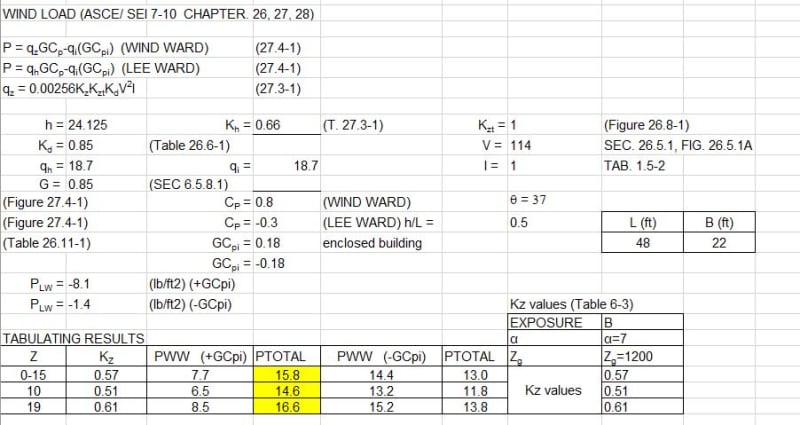Hello,
General question here, just caught up in my own thinking and would like some clarifications
when you have a partially enclosed building the GCpi is 0.18 and -0.18
when I calculate pressures for a building I calculate Windward and Leeward both twice, once with 0.18 and again with -0.18. then I combine Windward 0.18 with leeward 0.18 to get my total pressure on the building. I do the same combination with 0.18 to get a second total. then I compare the two totals to determine the governing case at each floor.
my question is: how do I know when to add Pww to Plw and when to subtract Pll from Pww?
see attached below for a screen shot of my calculations. Cell highlighted in yellow is the governing pressures. that Ptotal is Pww(+GCpi) - Plw(+GCpi)
the other Ptotal column not in yellow is Pww(-GCpi) + Plw(-GCpi). if I subtracted these two values I'd be left with the same values as those in the highlighted yellow column which is now leaving me scratching my head

General question here, just caught up in my own thinking and would like some clarifications
when you have a partially enclosed building the GCpi is 0.18 and -0.18
when I calculate pressures for a building I calculate Windward and Leeward both twice, once with 0.18 and again with -0.18. then I combine Windward 0.18 with leeward 0.18 to get my total pressure on the building. I do the same combination with 0.18 to get a second total. then I compare the two totals to determine the governing case at each floor.
my question is: how do I know when to add Pww to Plw and when to subtract Pll from Pww?
see attached below for a screen shot of my calculations. Cell highlighted in yellow is the governing pressures. that Ptotal is Pww(+GCpi) - Plw(+GCpi)
the other Ptotal column not in yellow is Pww(-GCpi) + Plw(-GCpi). if I subtracted these two values I'd be left with the same values as those in the highlighted yellow column which is now leaving me scratching my head

